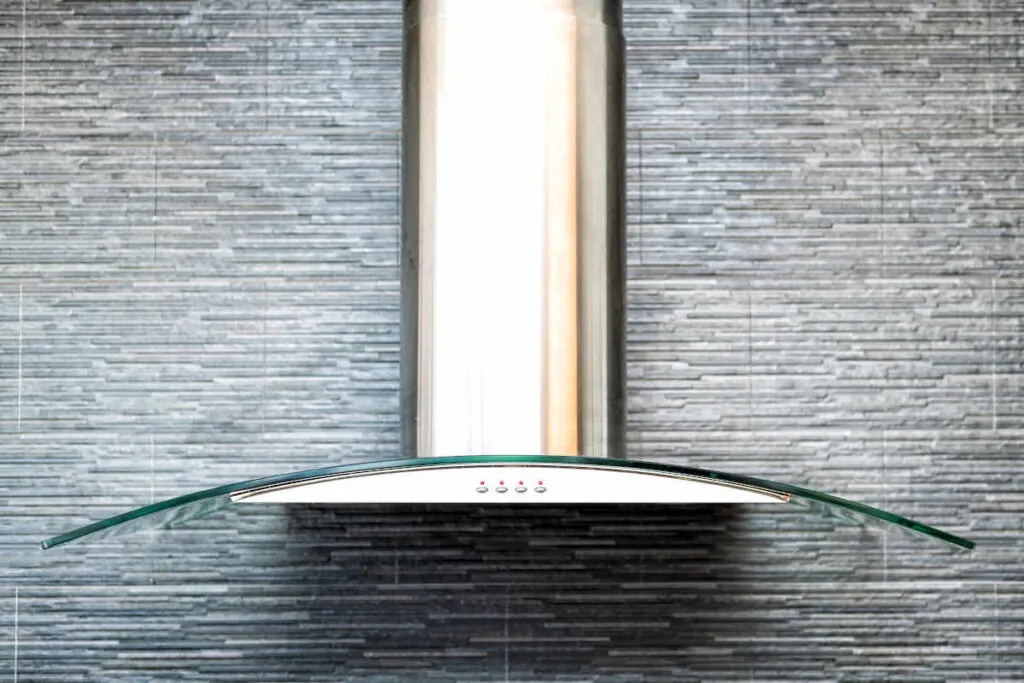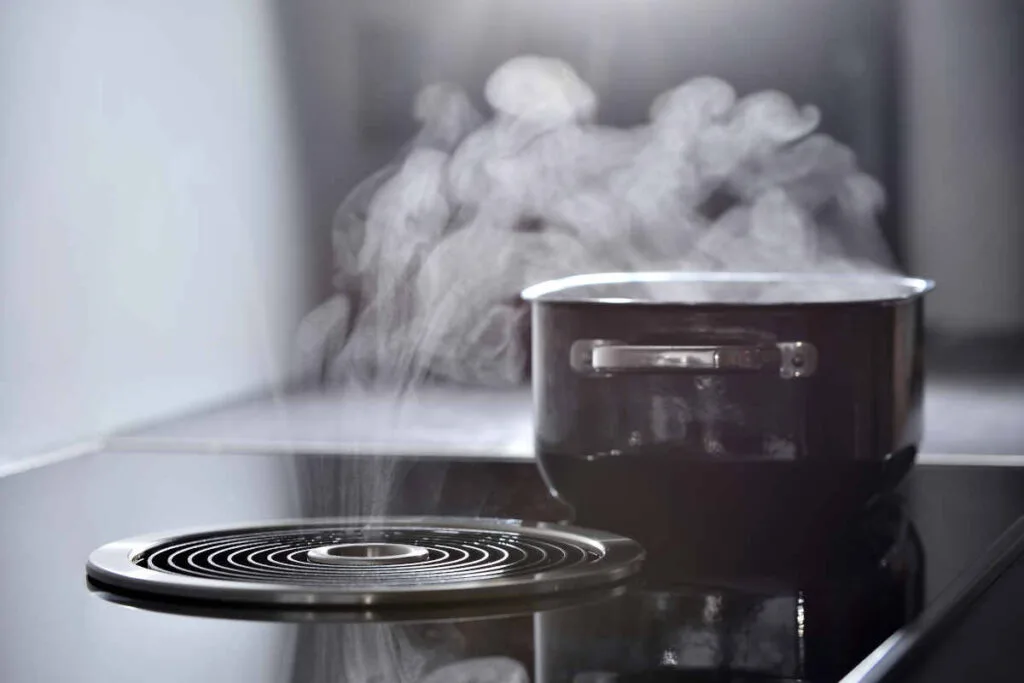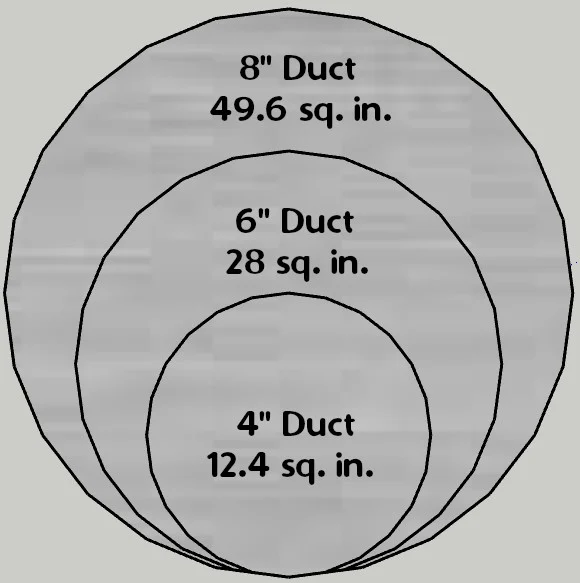Range hoods keep the indoor air clean from cooking odors and smoke. It is a vital appliance that should be installed in any kitchen. As with everything, we don’t notice if everything is working well, but if it starts causing problems it can drive us mad. House filled with smoke, smoke alarms going off will certainly be annoying.
There can be many reasons why a range hood is not effective. The most common reasons are that the filters on a ductless unit are missing/depleted or that the home is so airtight that the range hood does not have enough make-up air available.
There are many things that could cause the range hood to not effectively remove smoke and cooking odors. Next, I will discuss all of them and offer a solution for each.
Ductless Range Hood Filters Missing/Depleted
Ductless range hoods do not exhaust air to the outside. Instead, they filter it through activated carbon filters which remove some of the smoke and cooking odors.
The carbon filter has a huge surface area where the pollutants get caught. Although the surface area is huge, it will get filled up over time. Depending on how often and what type of cooking you do the filter should be replaced every 2 to 8 months.
I have seen people use ductless fans without carbon filters. By not having a fresh carbon filter installed, the range hood will not be effective and will just recirculate the smoke around the kitchen.
Don’t expect a ductless range hood to remove all of the cooking odors and smoke. However, if it is in working order it should at least filter the air so that the smoke alarms won’t go off.
The more strong smelling and smoking foods you cook, the more often the filter needs to be replaced.
If you wish to learn more about ductless range hoods, and find out whether they are supposed to remove grease, steam and smoke take a look at my previous article: Are Ductless Range Hoods Any Good
Solution
To make the ductless range hood effective again, you simply need to replace the carbon filter inside the hood. This can be usually accessed by removing the grease filters.
Luckily the carbon filters are somewhat standardized. You can measure the old filter, and just buy a new one with the same dimensions. 8-3/4 x 10-1/2 x 3/8 is the most common filter size(amazon link).
If you have never replaced the filter it’s a good idea to change it immediately regardless of how it looks like. On the other hand, if the filter has been changed recently and the hood is still ineffective, then your cooking habits don’t mesh with a ductless range hood(read next chapter) Make sure you buy a couple of replacement filters for the future as they need to be replaced at regular intervals.
If it is not possible to install a duct for a vented range hood, then I can recommend the Broan-Nutone Glacier(amazon link) series range hoods. They have much larger carbon filters and can handle more smoke than a standard ductless fan.
Wrong Type of Range Hood for the Type of Cooking

You might be expecting too much of your ductless range hood. If you do a lot of stir-frying, and cook dishes with a wok then a ductless range hood will not be sufficient. It simply can’t cope with the large amounts of smoke produced by high heat cooking with a wok.
Ductless range hoods are more suitable for medium heat frying, sauteing and for removing odors when boiling. (it will not remove steam).
Note: if you happen to have cast iron or carbon steel cookware, a ductless fan will not be able to filter the large amount of smoke generated when seasoning the pans.
Here’s an article on how to tell if your range hood is ducted or ductless.
Solution
Install a vented range hood. If you do the work yourself, and you have decent attic access, it will not take more than a couple of hours and will cost about $50 in parts + whichever range hood you choose.
If at all possible I highly recommend installing a vented range hood. Even if you hire a handyman to install it, the ductless hood filters will cost more in the long run.
| Item | View on amazon | |
| Roof Vent Cap* | View | |
| 6″ duct (ok for medium powered range hoods) | View | |
| 2x Duct clamps | View |
*The damper on this roof vent cap can be noisy when it is windy out. I have a very simple and cheap solution for it here.
Note: Before buying a new range hood check to see if your current one is not a “convertible”. This means that it works both as vented and vent-less. Then you can simply remove the carbon filter, connect it to a duct and start enjoying a smoke-free kitchen.
The Building is Too Airtight
This does not apply to ductless range hoods as they do not bring in outside air.
Modern homes are built so airtight that the range hood will have to fight for every cubic feet of air it exhausts out of the house. If you have a range hood that exhausts 500 cubic feet of air out of the house every minute, then the same amount of air must find it’s way back.
If there is not sufficient make-up air then the range hood will be much less effective.
Luckily there is an easy way to test if your range hood has enough make-up air.
- Close all doors and windows
- Turn on the range hood to the highest setting
- Open the front door about 5 inches, if the door will try to close on its own then there is not enough air available for the range hood.
Solution
The cheap and easy solution is to simply crack a window whenever using the range hood. This will allow for plenty of fresh air and the hood should be performing much better compared to when the window is closed.
There is are some downsides to doing this though.
- During wintertime, the cold draft will be uncomfortable
- Risk of back-drafting* if you forget the open the window
*Back-drafting is when air is pulled in from a chimney or other exhaust such as water heater smoke vent. Read more about back-drafting and the dangers that come with it.
The permanent and hassle-free solution that will work without anyone having to open a window is to install a fresh air inlet vent. This will provide makeup air to replace the air that the range hood exhausts and eliminate the risk for backdrafting.
I highly suggest installing a damper in the inlet vent. The damper will keep the vent normally closed. When the range hood is turned on, the air pressure will open it up and let fresh air in. This will avoid drafting when the range hood is not in use.
Here is an helpful guide if you would like to learn more about ventilation dampers.
Keep in mind the damper must be installed so it opens to the inside!
A vent with an integrated damper will not work since the damper will open to the outside.

Here are the parts needed to provide makeup air for a range hood. The 4-inch vent will provide enough makeup air for up to 500 CFM range hoods. If yours is more powerful, consider the 6-inch vent. Try to avoid the plastic vent covers as they tend to yellow over time.
The parts listed here are a bit more expensive, but they are built to last, and won’t cause you any problems for years to come. Cheap dampers can be annoyingly noisy when it’s windy.
| Item | View on amazon |
| 4-inch Stainless steel intake hood | View |
| 4-inch Spring Loaded Damper | View |
| 4-inch duct & 2 clamps* | View |
| Galvanized steel diffuser & flange | View |
*only small pieces are needed to attach the parts together
Before I installed an inlet vent to provide makeup air for the range hood my fireplace back-drafted every time I turned on the range hood. Even if there was no fire going, it was still bad since the air was drawn in through the soot-filled chimney. This filled the house with a “smokey” smell and tiny ash particles.
Make sure you don’t install the makeup air vent too close to the range hood, but it should be placed in the same room. Ideally in an opposite corner of the room.
Range Hood is Too Far Away from The Stove

The further away the range hood is from the stove, the more power is required to make sure that the smoked does not spread before reaching the range hood.
A low powered range hood that is mounted too high, will not move enough air, fast enough to prevent smoke from spreading before reaching the hood.
What is The Optimal Range Hood Height Above the Stove
The range hood should be placed 20″ to 24″ from the stove. The distance should be increased to 24″ to 30″ when using a gas stove.
To make the range hood as effective as possible, it should be placed as low as possible. This means 20″ for an electric stove and 24″ for a gas stove.
While placing the range hood so low will make it more effective, depending on the design of the hood, it can be in the way when cooking. My range hood is at an angle, and I can open a flap to increase capture efficiency so it is never in the way. That’s why I was able to install it low and still keep it out of my way.
Use the Back Burners
If your range hood is mounted too high, and you would rather not go through the trouble of lowering it, you could use the back burners.
The capture efficiency is much higher when using the back burners. If using the front burners the smoke tends to spread in front of the range hood.
So whenever cooking something that produces lots of smoke, try using the back burners and see if that helps!
Air Duct is Undersized or Too Long
The duct will drastically affect the performance of the range hood. I know from first hand knowledge. I tried to save money and installed a 4″ duct that I had laying around to a range hood that required a 6″ duct.
Even though the duct run was extremely short (6 ft.) the range hood was very noisy and did not exhaust smoke effectively. What was interesting was that it did not matter which speed I chose. It seemed to exhaust the same amount of smoke at low speed as the highest speed. It turned out that the low-speed setting was moving the maximum amount of air the 4-inch duct could effectively move.
When you take a look at the illustration below you can see the huge difference in surface area between a 4″ and a 6″ duct. The seemingly small 2″ difference in diameter makes a huge difference to the surface area. A 6-inch duct can easily be used to move twice as much air when compared to a 4-inch duct. The surface area is more than twice as big.

The length and complexity of the duct also play a huge role in how easy it is for the range hood to exhaust the pollutants.
I have seen 20 ft coils of ducting in the attic when the actual distance from the hood to the roof vent was less than 6 feet.
After cutting off the excess duct the range hood worked perfectly and had sufficient capacity.
Nice to know: Even though many people use flex ducts for range hoods, it is not approved by code. If you have a flex duct installed at the moment and it is undersized it would be wise to replace it with a correct duct to prevent any problems with insurance or home inspections. Read more about the why flex duct can’t be used for a range hood.
Solution
First remove the duct cover form the range hood and make sure that there is no reducing ring installed. The duct must be at least the same size as the range hoods flange.
If the duct size is reduced then unfortunately you have to replace the entire duct and possibly the vent hood as well. Be sure not to forget to install a damper and insulate the duct if you live in a cold climate. Otherwise the range hood will start drafting and dripping.
If there duct is correctly sized, then head up to the attic, check to see if the duct is as straight and short as possible.
Not Enough CFM for the Type of Cooking
In some very rare cases, the range hood could be too low capacity for high smoke cooking. However, most likely it is one of the previous issues that are making the range hood not effective.
Even the lowest CFM vented range hoods when placed at the correct height and connected to a correctly sized duct will effectively remove smoke even when cooking something that produces a lot of smoke.
The Hood is too Narrow
The range hood should always be as wide, or wider than the stove.
In order for the range hood to capture all of the smoke and food odors, it must cover the entire stove. It requires a lot of suction power to capture smoke if the range hood is not covering the pan/pot. If combined with a hood that is installed too high, there is a high chance that most of the smoke will spread before it reaches it.
This is most noticeable when cooking Asian dishes. Cooking something under high heat in a wok will produce enormous amounts of smoke. (My 600 CFM range hood mounted 20″ from the stove is barely able to capture everything when stir-frying vegetables)
Solution
Unfortunately, you have to replace the hood with a wider unit in order to make it perform better. Make sure that you have checked the previous tips, since addressing some of them might make the range hood more efficient and you don’t have to replace it.
Damper is Damaged
If you have gone through all of the above, then the last resort is to check the backdraft damper. It could be stuck shut, or halfway open, this will make it impossible, or very hard for the range hood to function.
Solution
Find the damper(most likely placed in the attic) and see if it opens easily.
Conclusion
There could be a myriad of reasons why a range hood is not effective. Starting from a house that is too airtight and ending with a missing filter on a ductless range hood. Most people are expecting too much out of a ductless range hood. They are not best suited for high smoke applications.
Often it is not necessary to buy a new range hood, instead the problem lies in one of the issues listed above.
I hope you found this article helpful. Please vote below and let me know how I could improve the articles in the future.
Thanks!
